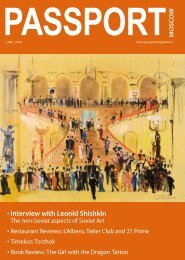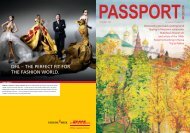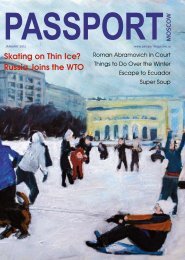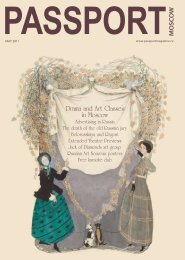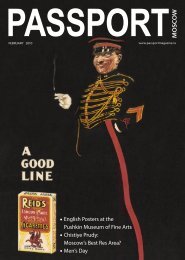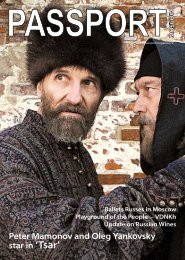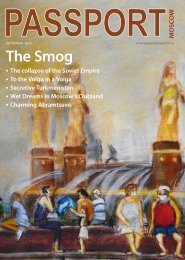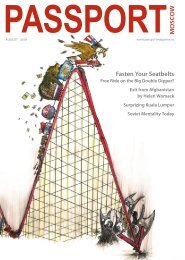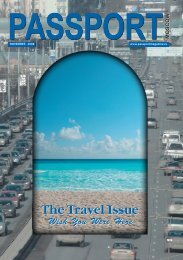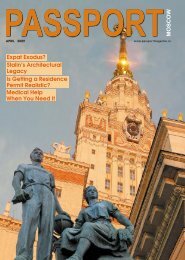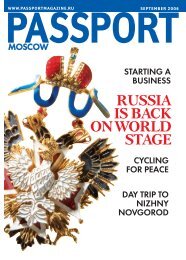Part one of Passport's guide to Moscow's favorite - Passport magazine
Part one of Passport's guide to Moscow's favorite - Passport magazine
Part one of Passport's guide to Moscow's favorite - Passport magazine
You also want an ePaper? Increase the reach of your titles
YUMPU automatically turns print PDFs into web optimized ePapers that Google loves.
Moscow Kremlin, Cross Chamber<br />
<strong>of</strong> the Patriarchal Palace<br />
June 19 – September 20<br />
Open: 10:00–17:00<br />
Except Thursday<br />
www.kreml.ru<br />
Go West<br />
To explain the name given <strong>to</strong> this exhibition we should<br />
go back <strong>to</strong> Soviet times, when you couldn’t go abroad simply<br />
by booking a ticket. It was considered incredible good<br />
fortune <strong>to</strong> win a ticket <strong>to</strong> a country as far away as Bulgaria.<br />
Even those who managed <strong>to</strong> get <strong>to</strong> neighbouring and<br />
friendly East European countries would recount for hours<br />
their impressions <strong>of</strong> a different world. The luckiest were diplomats<br />
and reporters who were sent on missions <strong>to</strong> completely<br />
inaccessible western countries, such as the United<br />
Kingdom, France or the United States. Any exhibition made<br />
by a Soviet pho<strong>to</strong>grapher who had been working in such<br />
countries caused huge interest in the media. There were<br />
fads as people copied haircuts and skirts, au<strong>to</strong>-enthusiasts<br />
discussed foreign racing cars for hours; common life in the<br />
streets in countries across the iron curtain held great fascination.<br />
This exhibition features works by eminent Soviet<br />
pho<strong>to</strong>graphers such as Vladimir Lagranzh, Valery Gende-<br />
Rote, Vassily Egorov. Their pho<strong>to</strong>s were not made for propaganda<br />
reasons, but for themselves, and for us, <strong>to</strong> understand<br />
what it was like looking at a different world.<br />
World Press Pho<strong>to</strong> 2009<br />
Red Oc<strong>to</strong>ber Fac<strong>to</strong>ry<br />
Bersenevskaya Naberezhnaya, 6, Building 3,<br />
Floor 4<br />
June 27–July 27<br />
11:00 – 20:00<br />
Open daily except Monday<br />
July 2009<br />
Previews<br />
Augsburg in the Kremlin<br />
The Kremlin Museums continue a tradition started some<br />
time ago – <strong>to</strong> present the treasures belonging <strong>to</strong> different nations<br />
and epochs. Having been able <strong>to</strong> view a fantastic exhibition<br />
<strong>of</strong> precious items from India this spring, a collection from<br />
the German Maximilian Museum is already being prepared.<br />
Augsburg is <strong>one</strong> <strong>of</strong> the oldest <strong>to</strong>wns in Germany, and thanks<br />
<strong>to</strong> its 17th century gold- and silversmiths, it was <strong>of</strong>ten labeled<br />
as the European jewellery capital. Works from gold-and silversmiths<br />
from the 16th – 17th centuries make up the highlights<br />
<strong>of</strong> this exhibition. At about this time, Augsburg set architectural<br />
trends in Eastern Europe, with its own Barocco style. Significant<br />
sculptural works include a “Fountain Lad” by Adriaen de<br />
Vries (ca. 1600) and other original sculptures from Augsburg’s<br />
monumental fountains that may be a revelation for Moscow<br />
audiences. Watches and porcelain sets, medals and bas-reliefs<br />
from as early as the Renaissance – all will be on display in the<br />
Kremlin through September.<br />
Lumiere Brothers’ Gallery<br />
Central House <strong>of</strong> Artists<br />
July 1 – August 24<br />
12:00–19:00<br />
Open daily except Mondays<br />
Krymsky Val, 10<br />
World Press Pho<strong>to</strong><br />
The Netherlands-based World Press Pho<strong>to</strong> Competition has existed<br />
since 1955, and is a unique space for independent pho<strong>to</strong>graphy, informational<br />
and cultural exchange. Nowadays this is the most prestigious<br />
contest in journalism pho<strong>to</strong>graphy. Every February, the jury select<br />
pho<strong>to</strong>graphs that best illustrate the previous year’s most remarkable<br />
events. The winners’ exhibition takes place in eighty countries. In Russia,<br />
the Red Oc<strong>to</strong>ber Fac<strong>to</strong>ry hosts the display this year. There is no<br />
fixed theme for the contest; that is determined by life itself. Whereas<br />
previous years’ winners presented works made in different hot spots <strong>of</strong><br />
the world, this year’s winner in the Every-day Life pho<strong>to</strong>graphy section,<br />
An<strong>to</strong>ny Suau, gives his vision <strong>of</strong> the financial crisis through his blackand-white<br />
image <strong>of</strong> an American sheriff’s deputy who moves with his<br />
gun drawn through a Cleveland home checking that the family has left<br />
their house due <strong>to</strong> a mortgage foreclosure. Among winners are Russian<br />
pho<strong>to</strong>graphers, <strong>to</strong>o. Yury Kozyrev won a prize in the Portrait nomination,<br />
Alexander Taran – in Sports Events and Alexey Bushov won a<br />
prize for his nature shots from Namibia.<br />
9



